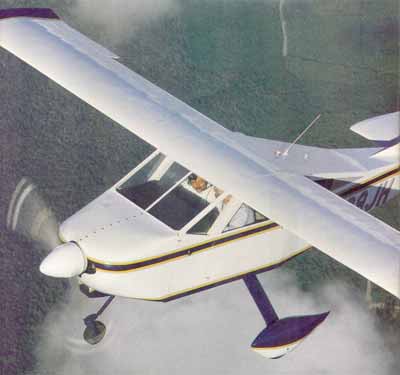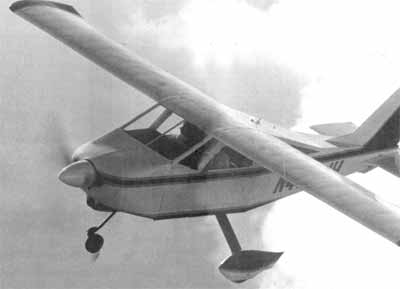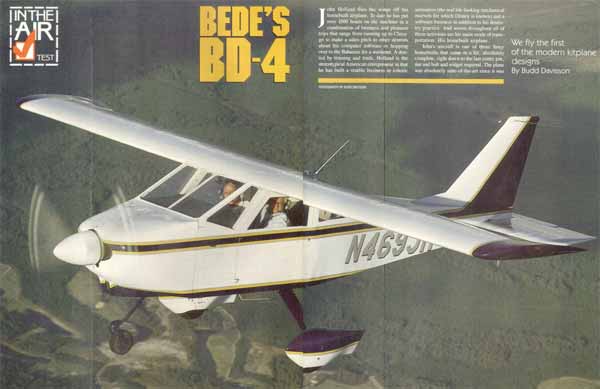PAGE TWO
Because John Holland's airplane is always in the process of being used,
most of us ground-bound souls only got to see the plane coming or going.
During one of these comings, I was able to corner John to talk a bit
about an airplane that most of us have relegated the design to the dark
corners of homebuilt history. Since he's a real user, therefore a real
believer in the airplane, he was only too happy to give me a few hours
to fill in a blank spot in my aeronautical knowledge. Most of this information
exchange took place on board N469JH as I got to know the airplane first
hand.
Although John has used his airplane in every sense of the word, walking
around it revealed no areas of deterioration or anything that indicated
any of the new concepts Bede was trying had begun to fail. There were
no cracks where the wing sections were epoxied together, nor was there
any-thing which indicated the fuselage skins were either deforming or
loosening from the fuselage structure. So apparently everything works.
 |
Carl Pascarell peaks around
the wing to fly formation with us. |
Boarding the BD-4 was unique because it's not often you get into an airplane
by just backing up and sitting down on the edge of the seat with your
butt and then swiveling your legs inside, putting one of your knees up
to your chin to get around the control stick. Once inside the doors were
closed and the three latches (two at the top corners and one at the bottom
rear corner) were pulled into position to make sure the door didn't try
to spring slightly out of the opening, ruining part of the airplane's
aerodynamic efficiency. I glanced around trying to figure out where everything
was and was amused to find what appeared to be a bicycle handle
sticking forward from behind our heads and above our shoulders. This
was a flap handle, which was simply pushed to one side and pulled down
to gain whatever notch of flaps was wanted.
The trim system consisted of a fat, round gnarled knob that sat between
the seat and a rudder trim which was a Vernier coming 45 degrees out
of the floor under the instrument panel between our collective
knees. The wide flat panel was impressive and although the
fuselage confines appeared to be approximately C-152 in terms of room,
the instrument panel said this was anything but a 152. Not only was
the airplane equipped with dual nav and comm systems, but it also had
a two-axis autopilot, which John uses quite often on his cross-country
trips — especially
when shooting approaches to minimum in the klag.
It was patently obvious when walking around the airplane that the nosewheel
was free swiveling which meant all taxiing was done with the brakes.
While glancing at that unfaired nosewheel, it appeared out of character
with the slick pants on the main gear. This, John pointed out, was
the result of cracks found in BD-4 nose gears and he wanted to have
his out where he could see it every time he did a walk around. Incidentally,
in case anybody has forgotten, there was a time when Jim Bede offered
the ultimate in retrofitting retractable gear — he put
doors on the wheel pants so the doors came down around the tires and
closed them in.
While I was strapping in, John lit the fire on the 180 Lycoming and pointed
us toward the runway. When approaching the end of the runway the seating
position mid-way between the wing made for limited visibility
to clear final. However, the gentle tap of a brake and the BD-4 neatly
turned on one wheel, courtesy of its free-swiveling nose wheel, giving
us a panoramic view of anything that was or wasn't out there. Out in
the middle of the runway the throttle started in and the airplane felt
like it was accelerating quite quickly when, in actuality,
we weren't. And it took a longish amount of time for the BD-4 to work
its way up to the 75 or 80 mph lift-off speed. In all probability the
nose could have been held off and the airplane flown off a little earlier
but with those stubby wings the BD-4 would have a tendency to mush a
little. The 75-80 mph speed John normally used gave a real positive break
and instantly put us into a rate of climb of approximately 7-800 feet
per minute. The takeoff run was long enough that the question entered
into my mind as to how well the plane got off with four people on board.
Best rate of climb seemed to be between 120-130 mph, which put the nose
high enough that it was a serious stretch to try to see over the top.
We were sitting fairly flat in relationship to the top of the cowling
and it just felt more natural to climb out a little faster just in order
to have better visibility.
We leveled out at 3000 feet to test out the controls and found the airplane
to have a feel that is a little hard to describe. This is definitely
not to be construed as a negative comment: Just that it's
a unique feel that can't be compared to anything else. In the first place,
I was prepared for the lack of dihedral to make itself known in lack
of roll stability, but this was absolutely not the case. In doing roll
stability tests, it turned out the airplane was average if not even a
little bit better than average in both static and dynamic. Pitch ability
was also better than average. Although it took four cycles to damp out,
more than half of the speed and altitude differential was damped out
in the first cycle alone.
If there is one sore point to the aircraft's controls, it is the lack
of harmony in regards to the rudder. The rudder is very powerful— so
powerful that at first it is difficult to coordinate smoothly and also
tends to get a little loose in yaw, which would undoubtedly
be tightened up by converting part of the rudder to this area. In all
probability this characteristic is less noticeable on those airplanes
using a smaller engine. On our two different flights in the airplane,
I had a chance to sample the airplane's cross-country capabilities and,
while it did have an unusual control feel, the BD-4 was stable
enough to hold altitude and heading almost unattended — even
in the slight chop we were running through. The visibility as would
be expected was Pacer-like because of the wing, which is not a serious
problem and the seating was good enough to not even be noticeably different
from what you expect in most small two-place airplanes.
In doing the stall series we unloaded in the low 60s. As would be expected,
the stall was a little sharp and tended to roll in one direction or the
other. I had to be very careful and actually study the ball
to keep it in the middle because of rudder sensitivity. However, try
as I may, I couldn't get the airplane to unload straight. The airplane
has a very slight feeling of being either out of rig or slightly out
of line. I couldn't absolutely credit that feeling to anything concrete,
but the feeling was strong enough that I didn't want to do any. accelerated
stalls for obvious reasons.
Running at about 23 square, the airspeed stabilized on 152, which is
almost exactly what John uses for cross-country planning. That's nowhere
close to the 175 or 180 mile an hour figure often banging around about
the design. Couple that number with the ability to file IFR in practically
everything except known icing and feel comfortable, and the airplane
is indeed a serious cross-country mount.
We shot a number of landings and I was impressed to see how speed stable
the BD-4 was in approach and found the two notches of flaps used were
primarily useful for get ting the nose down since they didn't seem to
do much to the actual approach characteristics. Holding 100 mph on final
and then bleeding down to the 90s on a short final, seemed to be a little
bit fast but gave us plenty of time to set the airplane up for a reasonably
smooth touchdown. The pitch rate during flair is very easy to control
and made finding the runway almost fun considering visibility over the
nose was gone, making it necessary to look out to the side as if landing
a Cessna 210 with half flaps. Once the airplane was on the runway it
rolled nice and straight and the rudder was plenty effective until we
got down to a fast walk, at which point the brakes easily kept things
straight.
 |
The nose pant is missing
because the front strut has been known to crack and the owner
wanted it out where he could inspect it better. |
John built his airplane in 1975 and it's instructive to look at his machine
since probably very few BD-4s are going to be worked as hard as this
one. Considering the design is well over 20 years old and there are very
few, if any, old wives' tales about the wings coming apart or the skins
delaminating on the fuselage, it had to be said that Jim Bede's concept
does work. However, one has to wonder where all those BD-4s are since
we don't see the type very often. Is it possible they died a lingering
death in the back of someone's workshop, or that they are one of those
airplanes that just quietly go about doing their job and never raise
much of a profile?
Whatever the BD-4's story is, it's interesting to stop and
think this is a kit machine that predates any of the kits we usually
discuss. And the plane is usable in the extreme. Although the structure
is unique, if Holland's airplane is typical at all, it obviously appears
to hold up and offers an interesting variation on today's super-smooth
composites.
Jim Bede has left his mark on aviation. As controversial as he may
be, it has to be said the reason he is controversial is because he
didn't run and hide and go through life in a passive, non-interacting
manner. Whether the rest of the world agreed is neither here nor there,
but at least Jim broke lots of new ground and the BD-4 may well be
one of first original postwar kitplanes. By the time he worked up through
the BD-5, the Wichita munchkin had absolutely proven there was a strong
market for kitplanes, which led to the development of so much of what
we now know as sport aviation. For that alone, we have to thank him. BD
For more pilot reports like this one go to PILOT REPORTS.
|

